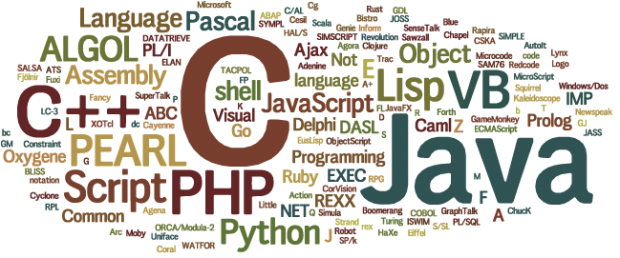CS 222

Programming Languages
Haskell Activity 6
Open the comand prompt / terminal, navigate to your desktop, and enter ghci. Open a code editor (e.g., Atom, Visual Studio Code, Sublime Text) and create a file activity06.hs; save it to the cs222 folder on your desktop. As you write functions, test them in ghci.
It is expected that you have read Ch. 5 of your Haskell book.
-
In
ghci, type:t mapto see the type signature of themapfunction. -
Repeat this process to see the type signature of the doubling function. Type
:t (* 2). - Test the following functions with an input number or character as an argument.
(* 2) -- "doubling" function(+ 4) -- "add 4" function(1 /) -- "reciprical" function(/ 4) -- "one fourth" function(> 5) -- "bigger than 5?" function(== ' ') -- "equals blank" function
- Write a function
doubleAll :: [Int] -> [Int]which uses the doubling function andmapto double each item in a list. For example:*Main> doubleAll [1..5] [2,4,6,8,10] - Write a function
addOneAllwhich usesmapand the “increment” function to add 1 to all elements. For example:*Main> addOneAll [1..5] [2,3,4,5,6] - Write a function
powerAllwhich usesmapand constructs a list of values formed by 2 to the power of the corresponding number in the list. For example:*Main> twoPowerAll [1,3,4] [2,8,16] - Test the following list comprehension by entering it in
ghci:[ x | x <- [1..100], x < 10] -
Use list comprehension to implement the function
quickSortwhich takes a unique list of numbers and sorts it using the quicksort algorithm, using the head of the list as the pivot. Recall that quicksort works by selecting a pivot to partition the list into a list of items less than the pivot and a list of items greater than the pivot. Then, it recursively calls quicksort to sort the smaller sized lists, and concatenates them together with the pivot after each list is sorted. Hint: refer to example 12 of book for help. -
Assuming that a list is ordered, write a function
insert'(yes - with apostrophe) which takes a list and a new element and returns the list with the element inserted in the correct position in the list. Use list comprehension for your solution. - Copy the following function and test it with an input list.
boomBangs xs = [ if x < 10 then "BOOM!" else "BANG!" | x <- xs, odd x] - Write a similar function called
fizzBuzzwhich takes a list of numbers. It should use a list comprehension to output a list of strings corresponding to the input numbers. Write “fizz” if the number is divisible by 3, “buzz” if it is divisible by 5, and “fizz buzz” if it is divisible by both. Otherwise, it should output the number as a string. Useshowto convert an integer to a string. For example:*Main> fizzBuzz [1..15] ["1","2","fizz","4","buzz","fizz","7","8","fizz","buzz","11","fizz","13","14","fizz buzz"]
If you finish early
- Recall that
elemreturns True or False whether a given element is in a list. Use it and a list comprehension to write a functionremoveUpperCasewhich takes a string and returns a string with all uppercase characters removed. For example:*Main> removeUppercase "Hello There" "ello here"
How to submit
Submit your file to Moodle which has all working function definitions.